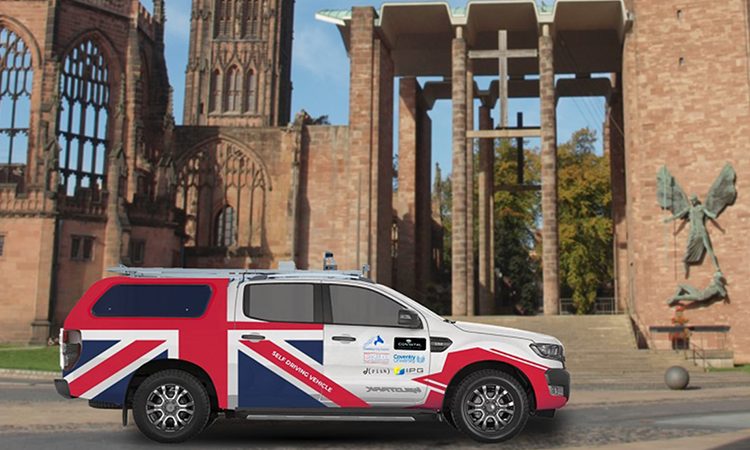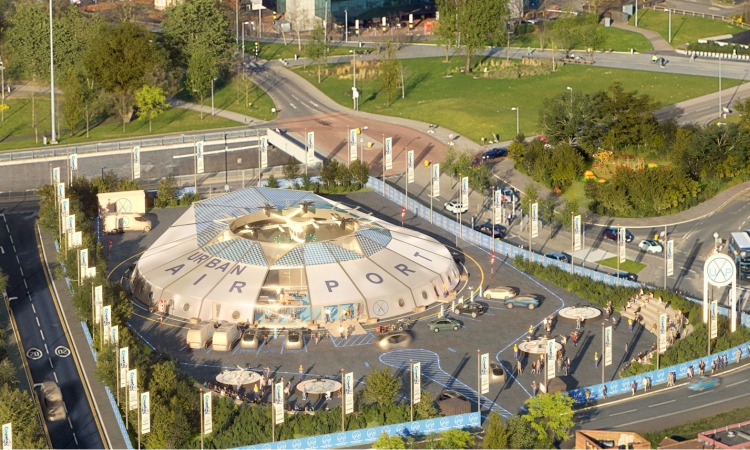Exploring the future of transportation in Coventry: The journey towards autonomous vehicles and beyond
- Like
- Digg
- Del
- Tumblr
- VKontakte
- Buffer
- Love This
- Odnoklassniki
- Meneame
- Blogger
- Amazon
- Yahoo Mail
- Gmail
- AOL
- Newsvine
- HackerNews
- Evernote
- MySpace
- Mail.ru
- Viadeo
- Line
- Comments
- Yummly
- SMS
- Viber
- Telegram
- Subscribe
- Skype
- Facebook Messenger
- Kakao
- LiveJournal
- Yammer
- Edgar
- Fintel
- Mix
- Instapaper
- Copy Link
Posted: 28 February 2023 | Sunil Budhdeo - Coventry City Council | No comments yet
For Intelligent Transport, Sunil Budhdeo, Transport Innovation Manager for Coventry City Council, provides insight into the various projects that the council is working on to advance the delivery and implementation of autonomous vehicle technology, as well as what he hopes to see more of across the wider transportation sector.


What does your role as Transport Innovation Manager entail?
Currently, as the Transport Innovation Manager for Coventry City Council, my role entails testing and developing any new technology for anything to do with transportation, which includes e-scooters, e-bikes, connected and autonomous vehicles (AVs) and parking sensors.
Coventry City Council is one of the first authorities in the world to have a vertiport displayed in the city, and our work with drones highlights our commitment to embracing new technologies”
More recently, another innovation that we’ve started to explore is the engagement of flying drones. This involves developing electric vertical take-off and landing (eVTOL) infrastructure in an urban environment, using drones for transporting passengers.
Coventry City Council is one of the first authorities in the world to have a vertiport displayed in the city, and our work with drones highlights our commitment to embracing new technologies. From medical supply-carrying drones to the logistics-carrying ones, drones have the potential to play a significant role in the UK transport sector, and that’s what we’re trying to explore.
What contribution has Coventry had in driving the development of autonomous vehicle technology in the UK?
As I mentioned earlier, Coventry is a pioneer in advancing new technological innovations. Our first Innovate UK funded project, the UK Auto Drive, was the largest funded projected in the country for connected and autonomous vehicles. We worked in partnership with original equipment manufacturers (OEMs) and Milton Keynes.
A company that’s based in Coventry developed the autonomous pods, which are still running in Milton Keynes. The Jaguar Land Rover vehicle was tested in a controlled environment, and we brought it back into Coventry once we finished testing it there. On the other hand, in Coventry, we tested the vehicles on open road rather than doing controlled trials. These trials were conducted in the real world; thus, the OEMs learned a lot.
Furthermore, we’ve also created a test bed environment in partnership with Transport for West Midlands (TfWM), where we’ve got a 271km test track set up for connected and autonomous vehicles to be tested in and around Coventry.
We’ve also newly engaged with a local company to develop an autonomous vehicle, which I’ll get into more detail about later on.
What are some of the challenges that the city council is facing in terms of trialling autonomous vehicle technology?
The biggest challenge at the moment would be funding. All of the projects that I’ve previously mentioned have only been possible because we were fortunate enough to secure funding and, thus, successfully allocated them to these projects.
Another challenge would be public perception: how can we get people to understand that autonomous vehicles will be a safe mode of transport? However, allowing test trials in a live environment, in fact, helped us to change this negative public perception. As part of the trials, we had people visiting and trialling the autonomous vehicles by having a ride in them. In addition, getting politicians and senior management to understand what the new development of technology is, was also a challenge for us.


Credit: Coventry University
How can autonomous vehicles help to achieve more equitable and accessible transport?
Autonomous vehicles – especially at the moment, because of legislation and the way that things are developing in the UK – are very good at making sure that we address security and safety as a key point. Thus, we don’t rush into putting vehicles out that have not been tested fully in an enclosed environment or in a testing ground. Once this testing is complete, then we try and release it, but we always make sure that safety drivers are in the vehicles.
We see the benefits of autonomous vehicles in not only improving safety, but also engaging with vulnerable users who could easily access on-demand services”
In the current climate, autonomous vehicles can also be utilised to drive public transport patronage, through on-demand services. For example, if there’s a vulnerable user who cannot access buses or is struggling to access other modes of public transport, then they end up being isolated and unable to benefit from the same level of freedom as other people. In such a situation, on-demand transport could be a solution. Thus, we see the benefits of autonomous vehicles in not only improving safety, but also engaging with vulnerable users who could easily access on-demand services. So, they can call up an autonomous taxi, which will then go and pick them up and drop them off. This level of involvement would be very useful.
One of the other projects that we’ve have worked on is Project Synergy, which is again funded by Innovate UK, and allows for the remote operations of autonomous vehicles. For example, one operator could start safely operating four to five vehicles remotely. As part of this project, the vehicle was tested on a road but was driven remotely from the head office. Despite being controlled remotely, for legal reason and to meet current legislations there was a safety driver in the vehicle.
Autonomous vehicle technology can be transferred into various other modes of transport, and it’s an on-demand service that can be operated. Ultimately, that’s where we see the benefits.
What is the future of autonomous vehicles in the UK’s wider public transport network?
We’re not just developing this technology for private vehicles, but we’re developing it for public transport… In the future, if we can have a bus operating autonomously or five buses operating remotely, then we can save a significant amount of cost.”
As I mentioned before, the technology is transferable, so we are currently working on a project called Very Light Rail in Coventry, which is another first for the city. While other metros require the digging up of roads – which can often disturb utilities, such as the gas, electricity and water lines – the Very Light Rail project is unique, as it doesn’t require roads to be dug up in order to create the tracks. The depth of the tracks isn’t much and it goes straight on top of the surface, making it more accessible and economical to start deploying. In addition, the Very Light Rail project is fully battery operated, so it doesn’t require electric power lines overhead, and so doesn’t need the depth of infrastructure.
Furthermore, the technology that we’ve developed with autonomous vehicles can be transferred onto buses, taxis and Very Light Rail. This shows that we’re not just developing this technology for private vehicles, but we’re developing it for public transport, as well. In the future, if we can have a bus operating autonomously or five buses operating remotely, then we can save a significant amount of cost.


Credit: Urban-Air Port
What projects are you most excited about that are currently in development at Coventry City Council and more widely across the industry?
We’ve done a lot of work on vehicles that travel on roads, so I’m definitely keen about venturing more into air transport, and Coventry’s Urban-Air Port will be key to this”
The project that I’m most excited about is working with drones and everything that flies. We’ve done a lot of work on vehicles that travel on roads, so I’m definitely keen about venturing more into air transport, and Coventry’s Urban-Air Port will be key to this.
While the Urban-Air Port covers a large amount of space, we can also develop and test these projects in smaller areas – the size of about four to five car parking spaces. For example, we can have city boxes, which allow autonomous drones to land and take off. These drones could also link into autonomous vehicles, which could allow for the distribution of goods in a more environmentally friendly way, as we look to save emissions and reduce congestion within the city.
Thus, we’re now exploring how we can link the future of transportation through air. We’re now working on drones for super highways – essentially creating highways in the sky. There’s a project that we’re currently working on, which goes from Coventry all the way to Reading. In this case, drones fly in a similar manner to a motorway. So, we are using the same sort of synergies between road transport and air transport, but we want to merge the two together to ensure that we meet our net zero targets, because that’s what will drive our development.
Essentially, we are trying to create a living lab in partnership with our university partners, academia partners and manufacturers. We want to have a connected living lab within Coventry, where seaports, airports, autonomous vehicles, electric vehicles – literally all connected autonomous vehicles – will be communicating with each other. We can then try and see if we can achieve our net zero targets intelligently.
The future is exciting – these are all the things that we’re excited about.


In five years’ time, which innovations would you like to see become more commonplace across the industry?
In five years’ time, I would like to see everything that we’ve spoken about today become more commonplace. I would like to see a Mobility-as-a-Service scenario where air, road and sea all come together to make our journeys totally seamless. For example, a vision that I have and have been working on is that, when a new housing estate is built, it will have the facility for a drone to deliver goods and parcels, which then internally will be delivered via electric autonomous vehicles, or e-bikes and e-scooters. From taxis to autonomous on-demand services and drones, I want to see a future where all of these innovative vehicle technologies are so easily accessible to people in these new housing developments that they no longer need to rely on having a personal vehicle.
I want to make sure that I can share all of these developments with other authorities across the country, who have not really been or are not able to be this forward-thinking, purely because they do not have the necessary resources or funding”
Of course, there are many things that need to be considered in order to achieve this. The biggest challenge would be, can I move the logistics? Can I transport delivery parcels? Many people may think that, if drones start delivering things for us, then we will receive them at our doorstep. However, this isn’t the case. In order for drones to be able to land and take-off, there needs to be a structure somewhere within an estate, where it can deliver the parcels to. For deliveries to reach doorsteps, sustainable e-scooters, e-bikes, cargo bikes or an autonomous pod are more viable options. Maybe, once all of these things have been deployed, post office delivery vans may become a concept of history, which would help us to meet our net zero targets.
Above all, I want to make sure that I can share all of these developments with other authorities across the country, who have not really been or are not able to be this forward-thinking, purely because they do not have the necessary resources or funding. We’ve done the work and, thus, we would like to share all of our findings with other authorities. Events like Intelligent Transport’s 2022 Transport Innovation Summit really help us to do that.
Coventry is a very forward-thinking city. With the support of our politicians and senior management, we’re able to deliver and explore a lot of these innovative vehicle technologies. Coventry is effectively one of the key UK’s hubs of developments in transportation.


Related topics
Air Quality, Connected & Autonomous Vehicles, Infrastructure & Urban Planning, Micro-mobility, Mobility Services, Public Transport, Sustainable Urban Transport, Vehicle & Passenger Safety
Related modes
Autonomous vehicles, Bus & Coach, Electric Vertical Takeoff and Landing Aircraft (eVTOL), Light Rail
Related cities
Coventry
Related countries
United Kingdom
Related organisations
Coventry City Council
Related people
Sunil Budhdeo








